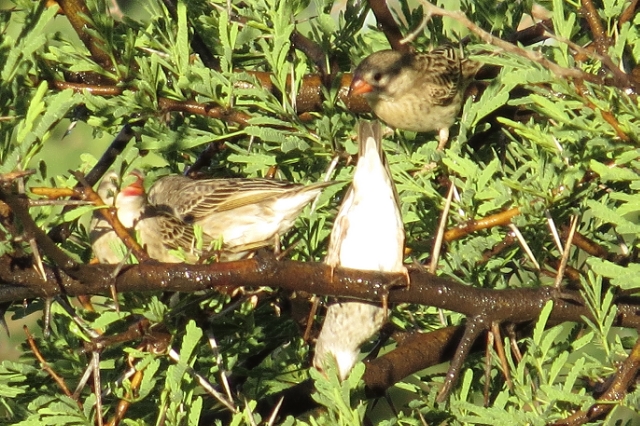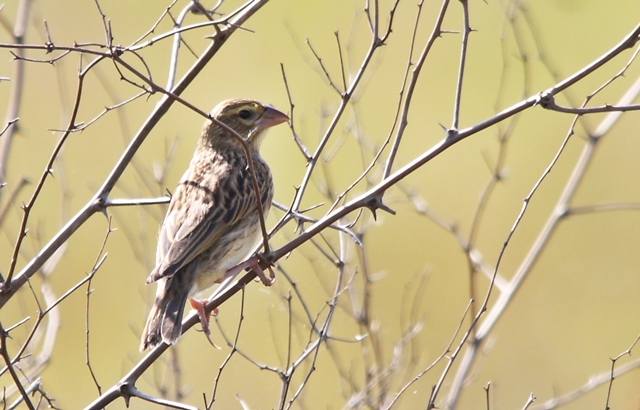The Red-billed Quelea (Quelea quelea) is the world's most abundant wild bird species, with an estimated adult breeding population of 1.5 billion pairs.[2] Some estimates of the overall population have been as large as 10 billion.[3] The entire population is found in sub-Saharan Africa and is generally absent from deeply forested regions and the southern reaches of South Africa. It is a small passerine bird of the weaver family Ploceidae.
Distribution
The distribution area of the Red-billed Quelea covers the majority of sub-Saharan Africa, excluding deep portions of rain forest in central Africa. It is also generally absent from the southern portion of South Africa.
Description
Flocks of Red-billed Quelea can reach thousands of birds
Red-billed Quelea are small birds and average-sized weaver-finches. They grow to 11–13 cm (4.3-5.1 in) long and attain a weight of 15 to 20 g (0.5-0.7 oz). During the breeding stage, the adult male is distinguished by his more colorful plumage and red bill. Breeding plumage in male queleas is unusually variable: comprising a facial mask which ranges from black to white in color, and breast and crown plumage which varies from yellowish to bright red. For the rest of the year both males and fledged non-breeding birds have plumage that resembles that of the adult female, which is overall a cryptic beige and cream coloration. The female's bill is yellow during breeding, and red during the non-breeding season.
Habits
Red-billed Quelea live and breed in huge flocks which can take up to 5 hours to fly past. They live mostly in steppe and savanna regions, but do not avoid human settlements. While foraging for food they may fly large distances each day without tiring. Their life expectancy is two to three years.
Reproduction
Breeding is localized and erratic but often colonies include tens of thousands to millions of pairs. The breeding season begins with the seasonal rains, which come at different times in different parts of their range - starting at the north-western edge around the beginning of November. The breeding males first weave half-complete ovoid nests from grass and straw. After the female has examined the construction and the mating has occurred, both partners complete the weaving of the nest. The female lays two to four light blue eggs, and incubates them for twelve days. After the chicks hatch, they are nourished for some days with caterpillars and protein-rich insects. After this time parents change to feeding the nestlings mainly seeds. The young birds fledge and become independent enough to leave their parents after approximately two weeks in the nest. They are sexually mature after just one year, but many birds die before reaching this stage and males may weave nests that go unused if the female dies.
Food
The food of the Red-billed Quelea consists of annual grasses, seeds and grain. As soon as the sun comes up, they come together in their huge flocks and co-operate in finding a suitable feeding place. After a successful search, they settle rapidly and can cause serious damage to crops. In the middle part of the day they rest in shady areas near water and preen. Birds seem to prefer drinking at least twice a day. In the evening they once again fly in search of food.
Enemies and population control
Being such a significant element of the savanna biomass, Red-billed Quelea flocks and colonies attract large numbers and diverse types of predators and scavengers. Birds known to live extensively off quelea include herons, storks, raptors, owls, hornbills, rollers, kingfishers, shrikes and corvids. Additionally, snakes, lizards and several types of mammals are regular predators, especially rodents and small carnivores.
They are regarded as pests by farmers because they can eliminate crops in a short period of time. Due to the large numbers and localised devastation of cereal crops, control actions have been undertaken. As many as 150-180 million birds have been killed but this appeared to have no effect on the overall quelea population and only temporary relief from crop damage. Many non-target birds appeared to have also been killed in these control operations and may have had severe population deprivations as a result.
Due to the birds living in communal roosts of many thousands of birds after the young have flown they can be easily targeted by special squads from the local agricultural organisation. When a village has complained of a flock stripping crops, the team will arrive at sundown when the mass roost has been located and will dig a shallow hole under the main roost trees. They then place a bundle of dynamite in and roll a barrel half filled with a petrol-diesel mixture that on detonation sends a huge blast into the tree, instantly killing the majority of roosting birds which then can be used as food for village dogs or pigs.
WEAVERS - BIRD OF THE MONTH - JUNE & JULY 2014*
- Lisbeth
- Site Admin
- Posts: 67388
- Joined: Sat May 19, 2012 12:31 pm
- Country: Switzerland
- Location: Lugano
- Contact:
Re: WEAVERS - BIRD OF THE MONTH - JUNE 2014
"Education is the most powerful weapon which you can use to change the world." Nelson Mandela
The desire for equality must never exceed the demands of knowledge
The desire for equality must never exceed the demands of knowledge
Re: WEAVERS - BIRD OF THE MONTH - JUNE 2014
10.03. - 24.03.2015 From Berg to bush
19.11. - 01.12.2015 KTP
19.11. - 01.12.2015 KTP
Re: WEAVERS - BIRD OF THE MONTH - JUNE 2014
Red-billed Quelea Quelea quelea
Kruger National Park

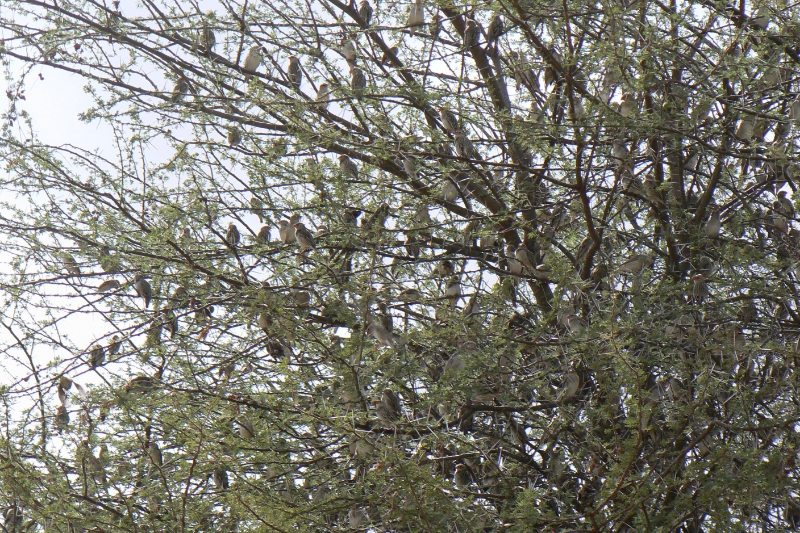
Red-billed Quelea roost together in a huge flock in several trees and bust into loud song.
Kruger National Park


Red-billed Quelea roost together in a huge flock in several trees and bust into loud song.
- nan
- Posts: 26310
- Joined: Thu May 31, 2012 9:41 pm
- Country: Switzerland
- Location: Central Europe
- Contact:
Re: WEAVERS - BIRD OF THE MONTH - JUNE 2014
Red-billed Quelea/Travailleur à bec rouge
 male+female
male+female
 all a tree
all a tree
 male+female
male+female  all a tree
all a treeKgalagadi lover… for ever
https://safrounet.piwigo.com/
https://safrounet.piwigo.com/
- Amoli
- Posts: 6032
- Joined: Fri Jun 01, 2012 4:30 am
- Country: South Africa
- Location: Kempton Park
- Contact:
Re: WEAVERS - BIRD OF THE MONTH - JUNE 2014
Red-billed Queleas:
Kruger National Park
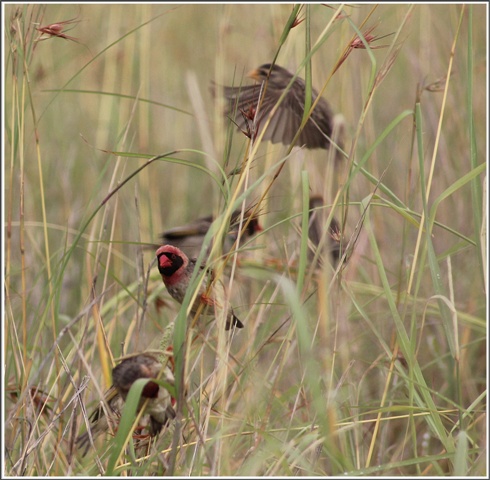
Rietvlei

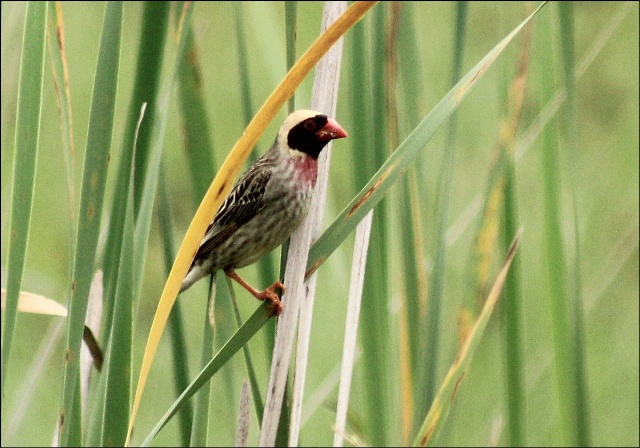
Kruger National Park

Rietvlei


Pretoriuskop
Satara
Shingwedzi
20-30 Dec 2014
Satara
Shingwedzi
20-30 Dec 2014
- Lisbeth
- Site Admin
- Posts: 67388
- Joined: Sat May 19, 2012 12:31 pm
- Country: Switzerland
- Location: Lugano
- Contact:
Re: WEAVERS - BIRD OF THE MONTH - JUNE 2014
Genus Euplectes
The Yellow-crowned Bishop (Euplectes afer) is a species of passerine bird in the family Ploceidae native to Africa south of the Sahara.It highly sexually dimorphic in its breeding season, during which the male adopts a distinctive yellow and black plumage, contrasting with the female's predominantly brown coloration. Three subspecies are recognised.
Taxonomy
The Yellow-crowned Bishop was first described by the German naturalist Johann Friedrich Gmelin in 1789. It and the Fire-fronted Bishop have occasionally been placed in the separate genus Taha but DNA places it in Euplectes, but with no close relatives. In captivity it has interbred with the Northern Red Bishop.[3] Alternate common names include: Golden Bishop, Napoleon Bishop, Napoleon Weaver, Black-winged Golden Bishop, Goudgeelvink (in Afrikaans), Napoleonweber (in Dutch), Euplecte vorabé (in French), Napoleonweber (in German), and Obispo Coronigualdo (in Spanish).
Description
The Yellow-crowned Bishop is 95–105 mm (3.7–4.1 in) in length and 15 g (0.53 oz) in weight. During the breeding season it is sexually dimorphic—that is, the observable characteristics of the males become more apparent. During the breeding season, the male has distinctive golden yellow and black plumage. The bill of both sexes is short and conical. The color of the male's bill is black during breeding season; by contrast, during non-breeding season, the male's bill is horn in color, as is the female's. The legs and feet are pinkish brown. The male has a black lower face, throat, breast and belly, a wide black collar on the back of the neck, and a brilliant yellow crown, forehead, and hindcrown. There is a yellow patch on the shoulder, and the rump and back are yellow. The wings and tail are brown. During non-breeding seasons the male plumage looks like the female plumage. The female Yellow-crowned Bishop has pale brown upperparts, with darker streaking. The eyebrow is paler and the underparts are off-white with fine dark streaks on the breast and flanks.
The male in breeding plumage resembles the Yellow Bishop, but the latter species is larger and lacks the yellow crown. Non-breeding males and females can be confused with those of the Southern Red Bishop, but have white rather than the buff-coloured underparts of the latter.
Distribution and habitat
The Yellow-crowned Bishop is native to the African countries of: Angola, Benin, Botswana, Burkina Faso, Cameroon, Central African Republic, Chad, Republic of the Congo, Democratic Republic of the Congo, Ivory Coast, Ethiopia, Gabon, Gambia, Ghana, Guinea, Guinea-Bissau, Kenya, Lesotho, Liberia, Mali, Mauritania, Mozambique, Namibia, Niger, Nigeria, Senegal, Sierra Leone, South Africa, Sudan, Tanzania, Togo, Uganda, Zambia, and Zimbabwe. It has been introduced in the following countries: the US (Florida), Jamaica, Japan, Portugal, Puerto Rico, and Venezuela. It prefers habitats such as grasslands, vlies, and pans. It likes wheat and sorghum fields, and weedy vegetation along wetlands.
Behaviour
The Yellow-crowned Bishop eats insects, grain, and seeds. It lives in flocks with both males and females. In non-breeding seasons the flocks may contain weavers and sparrows. The call is a "high-pitched, rasping, buzzing swizzling, somewhat insect-like: zzzzzzz, zzit, zzit, zzzz". Nesting is November–May, peaking from December–March, and males are polygynous, but the males do not breed in colonies. Each male will build two or more oval nests with a top opening, attracting a female to each nest by flaring their yellow feathers and display flights. Yellow-crowned Bishop are gregarious and nomadic, wandering to breeding areas in response to rainfall. Nests are built among standing stems of grasses or sedges or shrubs. Bent over stems of live grass help hide the nest. The female will lay from two to four white eggs. Egg incubation is done solely by the females and lasts 12–14 days. Newborn chicks leave the nest after 11–13 days and are fully independent after an additional five week.
The Yellow-crowned Bishop (Euplectes afer) is a species of passerine bird in the family Ploceidae native to Africa south of the Sahara.It highly sexually dimorphic in its breeding season, during which the male adopts a distinctive yellow and black plumage, contrasting with the female's predominantly brown coloration. Three subspecies are recognised.
Taxonomy
The Yellow-crowned Bishop was first described by the German naturalist Johann Friedrich Gmelin in 1789. It and the Fire-fronted Bishop have occasionally been placed in the separate genus Taha but DNA places it in Euplectes, but with no close relatives. In captivity it has interbred with the Northern Red Bishop.[3] Alternate common names include: Golden Bishop, Napoleon Bishop, Napoleon Weaver, Black-winged Golden Bishop, Goudgeelvink (in Afrikaans), Napoleonweber (in Dutch), Euplecte vorabé (in French), Napoleonweber (in German), and Obispo Coronigualdo (in Spanish).
Description
The Yellow-crowned Bishop is 95–105 mm (3.7–4.1 in) in length and 15 g (0.53 oz) in weight. During the breeding season it is sexually dimorphic—that is, the observable characteristics of the males become more apparent. During the breeding season, the male has distinctive golden yellow and black plumage. The bill of both sexes is short and conical. The color of the male's bill is black during breeding season; by contrast, during non-breeding season, the male's bill is horn in color, as is the female's. The legs and feet are pinkish brown. The male has a black lower face, throat, breast and belly, a wide black collar on the back of the neck, and a brilliant yellow crown, forehead, and hindcrown. There is a yellow patch on the shoulder, and the rump and back are yellow. The wings and tail are brown. During non-breeding seasons the male plumage looks like the female plumage. The female Yellow-crowned Bishop has pale brown upperparts, with darker streaking. The eyebrow is paler and the underparts are off-white with fine dark streaks on the breast and flanks.
The male in breeding plumage resembles the Yellow Bishop, but the latter species is larger and lacks the yellow crown. Non-breeding males and females can be confused with those of the Southern Red Bishop, but have white rather than the buff-coloured underparts of the latter.
Distribution and habitat
The Yellow-crowned Bishop is native to the African countries of: Angola, Benin, Botswana, Burkina Faso, Cameroon, Central African Republic, Chad, Republic of the Congo, Democratic Republic of the Congo, Ivory Coast, Ethiopia, Gabon, Gambia, Ghana, Guinea, Guinea-Bissau, Kenya, Lesotho, Liberia, Mali, Mauritania, Mozambique, Namibia, Niger, Nigeria, Senegal, Sierra Leone, South Africa, Sudan, Tanzania, Togo, Uganda, Zambia, and Zimbabwe. It has been introduced in the following countries: the US (Florida), Jamaica, Japan, Portugal, Puerto Rico, and Venezuela. It prefers habitats such as grasslands, vlies, and pans. It likes wheat and sorghum fields, and weedy vegetation along wetlands.
Behaviour
The Yellow-crowned Bishop eats insects, grain, and seeds. It lives in flocks with both males and females. In non-breeding seasons the flocks may contain weavers and sparrows. The call is a "high-pitched, rasping, buzzing swizzling, somewhat insect-like: zzzzzzz, zzit, zzit, zzzz". Nesting is November–May, peaking from December–March, and males are polygynous, but the males do not breed in colonies. Each male will build two or more oval nests with a top opening, attracting a female to each nest by flaring their yellow feathers and display flights. Yellow-crowned Bishop are gregarious and nomadic, wandering to breeding areas in response to rainfall. Nests are built among standing stems of grasses or sedges or shrubs. Bent over stems of live grass help hide the nest. The female will lay from two to four white eggs. Egg incubation is done solely by the females and lasts 12–14 days. Newborn chicks leave the nest after 11–13 days and are fully independent after an additional five week.
"Education is the most powerful weapon which you can use to change the world." Nelson Mandela
The desire for equality must never exceed the demands of knowledge
The desire for equality must never exceed the demands of knowledge
- Amoli
- Posts: 6032
- Joined: Fri Jun 01, 2012 4:30 am
- Country: South Africa
- Location: Kempton Park
- Contact:
Re: WEAVERS - BIRD OF THE MONTH - JUNE 2014
Yellow crowned Bishop, Rietvlei
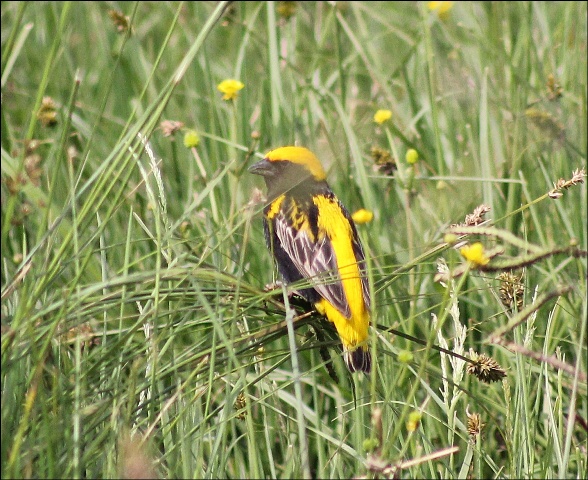


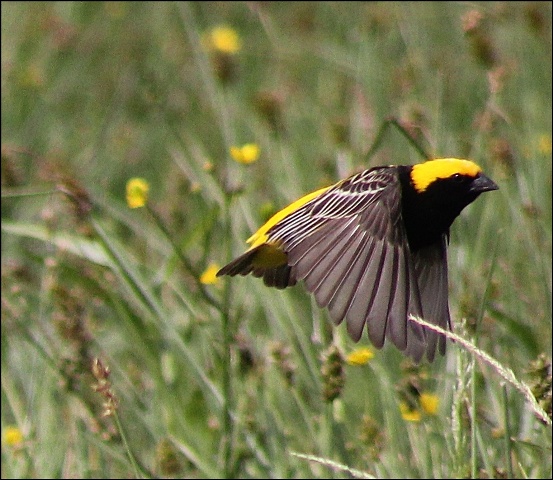




Pretoriuskop
Satara
Shingwedzi
20-30 Dec 2014
Satara
Shingwedzi
20-30 Dec 2014
- Lisbeth
- Site Admin
- Posts: 67388
- Joined: Sat May 19, 2012 12:31 pm
- Country: Switzerland
- Location: Lugano
- Contact:
Re: WEAVERS - BIRD OF THE MONTH - JUNE 2014
The Black-winged Red Bishop (Euplectes hordeaceus), formerly known in southern Africa as the Fire-crowned Bishop, is a resident breeding bird species in tropical Africa from Senegal to Sudan and south to Angola, Tanzania, Zimbabwe and Mozambique.
This common weaver occurs in a range of open country, especially tall grassland and often near water. It builds a spherical woven nest in tall grass. 2-4 eggs are laid.
The Black-winged Red Bishop is a stocky 13–15 cm bird. The breeding male is scarlet apart from his black face, belly and wings and brown tail. The conical bill is thick and black. He displays prominently, singing high-pitched twitters from tall grass, puffing out his feathers or performing a slow hovering display flight.
The non-breeding male is yellow-brown, streaked above and shading to whitish below. It has a whitish supercilium. It resembles non-breeding male Northern Red Bishop, but is darker and has black wings. Females are similar, but paler. Young birds have wider pale fringes on their flight feathers.
The Black-winged Red Bishop is a gregarious species which feeds on seed, grain and some insects.
The Southern Red Bishop or Red Bishop (Euplectes orix) is a small passerine bird belonging to the bishop and widowbird genus Euplectes in the weaver family Ploceidae. It is common in wetlands and grassland in Africa south of the Equator. North of the Equator, it is replaced by the Northern Red Bishop or Orange Bishop (E. franciscanus) which was formerly regarded as a subspecies of this species.
Description
It is 10–11 centimetres long and has a thick conical bill. Breeding males are brightly coloured with red (occasionally orange) and black plumage. The forehead, face and throat are black and the rest of the head is red. The upperparts are red apart from the brown wings and tail. The upper breast and under tail-coverts are red while the lower breast and belly are black. The non-breeding male and female have streaky brown plumage, paler below. Females are smaller than the males.
It has various twittering calls and a nasal contact call. The male has a buzzing song.
Breeding males of the Northern Red Bishop have a red throat, black extending further back on the crown and long tail-coverts which almost cover the tail. The females and non-breeding males are almost identical to those of the Southern Red Bishop.
Distribution and habitat
It occurs from South Africa north to Angola, southern and eastern parts of the Democratic Republic of Congo, southern Uganda and south-west Kenya. It is largely absent from the Namib Desert and Kalahari.
In the breeding season it is found near water among grass, reeds, sedges or crops such as sugar cane. Outside the breeding season it will venture into drier grassland and savanna habitats.
It is a fairly gregarious bird, nesting in colonies and foraging in flocks. It feeds on seeds and some insects. It often roosts in mixed flocks with other members of the weaver family.
At the start of the breeding season, the males build several nests to attract females. They perform a display flight with their feathers fluffed up. They are polygynous and mate with several females. The nest is most commonly built among reeds and is made of grasses and other plant materials woven together. Two to four eggs are laid.
This common weaver occurs in a range of open country, especially tall grassland and often near water. It builds a spherical woven nest in tall grass. 2-4 eggs are laid.
The Black-winged Red Bishop is a stocky 13–15 cm bird. The breeding male is scarlet apart from his black face, belly and wings and brown tail. The conical bill is thick and black. He displays prominently, singing high-pitched twitters from tall grass, puffing out his feathers or performing a slow hovering display flight.
The non-breeding male is yellow-brown, streaked above and shading to whitish below. It has a whitish supercilium. It resembles non-breeding male Northern Red Bishop, but is darker and has black wings. Females are similar, but paler. Young birds have wider pale fringes on their flight feathers.
The Black-winged Red Bishop is a gregarious species which feeds on seed, grain and some insects.
The Southern Red Bishop or Red Bishop (Euplectes orix) is a small passerine bird belonging to the bishop and widowbird genus Euplectes in the weaver family Ploceidae. It is common in wetlands and grassland in Africa south of the Equator. North of the Equator, it is replaced by the Northern Red Bishop or Orange Bishop (E. franciscanus) which was formerly regarded as a subspecies of this species.
Description
It is 10–11 centimetres long and has a thick conical bill. Breeding males are brightly coloured with red (occasionally orange) and black plumage. The forehead, face and throat are black and the rest of the head is red. The upperparts are red apart from the brown wings and tail. The upper breast and under tail-coverts are red while the lower breast and belly are black. The non-breeding male and female have streaky brown plumage, paler below. Females are smaller than the males.
It has various twittering calls and a nasal contact call. The male has a buzzing song.
Breeding males of the Northern Red Bishop have a red throat, black extending further back on the crown and long tail-coverts which almost cover the tail. The females and non-breeding males are almost identical to those of the Southern Red Bishop.
Distribution and habitat
It occurs from South Africa north to Angola, southern and eastern parts of the Democratic Republic of Congo, southern Uganda and south-west Kenya. It is largely absent from the Namib Desert and Kalahari.
In the breeding season it is found near water among grass, reeds, sedges or crops such as sugar cane. Outside the breeding season it will venture into drier grassland and savanna habitats.
It is a fairly gregarious bird, nesting in colonies and foraging in flocks. It feeds on seeds and some insects. It often roosts in mixed flocks with other members of the weaver family.
At the start of the breeding season, the males build several nests to attract females. They perform a display flight with their feathers fluffed up. They are polygynous and mate with several females. The nest is most commonly built among reeds and is made of grasses and other plant materials woven together. Two to four eggs are laid.
"Education is the most powerful weapon which you can use to change the world." Nelson Mandela
The desire for equality must never exceed the demands of knowledge
The desire for equality must never exceed the demands of knowledge
- Lisbeth
- Site Admin
- Posts: 67388
- Joined: Sat May 19, 2012 12:31 pm
- Country: Switzerland
- Location: Lugano
- Contact:
Re: WEAVERS - BIRD OF THE MONTH - JUNE 2014
The Yellow Bishop, Cape Bishop, Cape Widow or Yellow-rumped Widow (Euplectes capensis) is a resident breeding bird species in Angola, Botswana, Burundi, Cameroon, Congo, Equatorial Guinea, Ethiopia, Kenya, Lesotho, Malawi, Mozambique, Nigeria, Rwanda, South Africa, Sudan, Swaziland, Tanzania, Uganda, Zambia and Zimbabwe.
This common weaver occurs in less arid vegetated areas, such as fynbos, moist grassland and bracken-covered valleys at altitudes from sea level to the Ethiopian highlands.
Description
The Yellow Bishop is a stocky 15 centimetres (5.9 in) long bird. The breeding male is black apart from his bright yellow lower back, rump, and shoulder patches, and brown edging to the wing feathers. He has a short crest, thick conical black bill, and a relatively short tail. His bill size varies dramatically between races.[
In non-breeding plumage, the black plumage is replaced by heavily streaked buffy-brown, and the bill is pale. The yellow shoulders and rump remain, and are a distinction from the female which lacks the contrasting colour patches. The juveniles and females are notoriously difficult to identify in the field, appearing identical to the juveniles and females of several other bishops and widowbirds as well as some seadeaters.
In the breeding season they are usually solitary or in pairs, but the non-breeding Yellow Bishop is gregarious, often forming flocks with other 'mixed euplectes'.
They feed on seed, grain and some insects.
This common weaver occurs in less arid vegetated areas, such as fynbos, moist grassland and bracken-covered valleys at altitudes from sea level to the Ethiopian highlands.
Description
The Yellow Bishop is a stocky 15 centimetres (5.9 in) long bird. The breeding male is black apart from his bright yellow lower back, rump, and shoulder patches, and brown edging to the wing feathers. He has a short crest, thick conical black bill, and a relatively short tail. His bill size varies dramatically between races.[
In non-breeding plumage, the black plumage is replaced by heavily streaked buffy-brown, and the bill is pale. The yellow shoulders and rump remain, and are a distinction from the female which lacks the contrasting colour patches. The juveniles and females are notoriously difficult to identify in the field, appearing identical to the juveniles and females of several other bishops and widowbirds as well as some seadeaters.
In the breeding season they are usually solitary or in pairs, but the non-breeding Yellow Bishop is gregarious, often forming flocks with other 'mixed euplectes'.
They feed on seed, grain and some insects.
"Education is the most powerful weapon which you can use to change the world." Nelson Mandela
The desire for equality must never exceed the demands of knowledge
The desire for equality must never exceed the demands of knowledge



